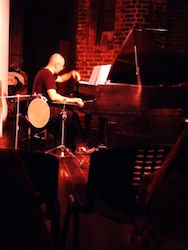
 |
Mirror chords are another ingredient in my brick and mortar collection. The mirror of a chord can be defined as the chord whose intervals are in reverse order in respect to the original. For example, the mirror of the chord C2 G2 B2, starting from B2, is B2 D3# A3#. (Obtained adding a M3 to B2, and then a P5 to D3#). In frequency domain the mirror operation takes a particularly simple form. Mirror chords are of course nothing new and they have been used frequently in the 20th century. A mirror operator can be used directly to obtain prolungations of the chords derived from inharmonic series. For example, the following figure shows the mirrors of the inharmonic chords obtained using n=11. The mirror chords are generated using the highest pitch of the inharmonic chord (F#5) as a pivot (they are reported in the same order of the inharmonic series shown in the inharmonic series page). In a composition mirror chords provide further harmonic and melodic possibilities, However the main disadvantage is that they include pitches that are not present in the original chord. As a consequence if an inharmonic chord is used to identify a scale, and that scale is used throughout a section of a piece, the introduction of a mirror will obtain pitches outside of the scale, and so it will "modulate". For this reason I generate constrained mirror chords, defined as the mirror chords that are closest, pitchwise, to a given scale, or to put it in a simpler way they are modal inversions. Obtaining such chords requires a simple search algorhythm. The resulting mirror chords are shown below. The scale for each chord is now the same scale of the inharmonics chords with n=11.

 |
||
|